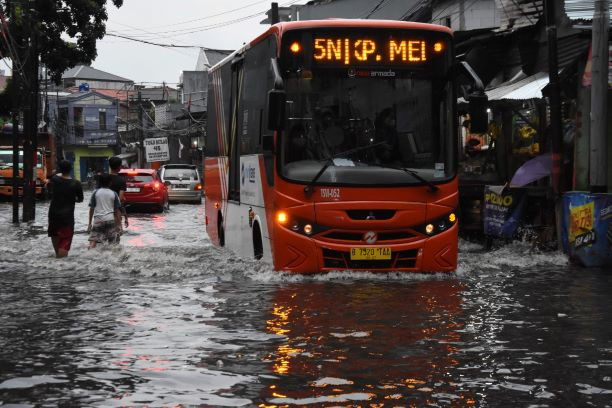Jakarta prepares for extreme weather through February 2023

A public bus drives through an inundated road section near Warung Buncit market in South Jakarta on Oct. 15. The Jakarta Post/Asia News Network
JAKARTA — The Jakarta administration is beefing up its preparations for the extreme weather that is forecast to hit the capital until February as a result of the La Niña weather phenomenon, which typically causes intense rainfall in Indonesia.
Acting governor Heru Budi Hartono said thunderstorms were expected from November to February that might cause damage across the city from flooding and landslides, as well as strong winds.
The city administration held a readiness roll call on Wednesday in Cibubur, East Java, which involved representatives from the Office of the Coordinating Human Development and Culture Minister, the National Disaster Mitigation Agency (BNPB), the Indonesian Military (TNI) and the National Police, as well as a number of humanitarian organizations.
“We will also conduct flood disaster mitigation,” Heru said, as quoted by Tempo.
Jakarta Disaster Mitigation Agency (BPBD) chief Isnawa Adji had said earlier on Monday that the capital was calling on local businesses to implement a work from home (WFH) policy during bad weather.
Article continues after this advertisement“This is a suggestion. Of course, company managers know what their organizations need,” Isnawa said, as reported by Kompas.
Article continues after this advertisementHeavy rainfall typically cause flooding along Jakarta’s streets and in low-lying residential areas, leading to hours-long traffic jams.
In early October, three 13-year-old students were killed when floodwaters surged into a school in South Jakarta and caused two walls to collapse.
Jakarta has repeatedly experienced massive citywide flooding in the past three decades, most recently in 2020.
The 2007 flooding is reportedly the worst to date, with floodwaters reaching 5 meters in some parts of the capital.
The disaster killed dozens of people, displaced thousands and paralyzed the city for days, with overall damages reaching an estimated Rp 5.2 trillion (US$332 million).
Jakarta has developed into a megalopolis with a population of around 12 million, from a population of just 540,000 residents in the 1940s.
Unchecked development has also left Jakarta with less than 10 percent of green open space, which has contributed to the severity of annual flooding in the capital.
RELATED STORIES
Indonesian capital slammed by monsoon floods, more than 1,000 forced to evacuate